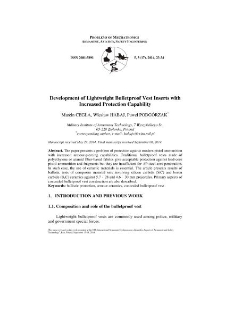Nasza Biblioteka Cyfrowa udostępnia 1 868 obiektów cyfrowych
Obiekt
Tytuł: Development of Lightweight Bulletproof Vest Inserts with Increased Protection Capability ; Development of Lightweight Bulletproof Vest Inserts with Increased Protection Capability
Współtwórca:
Wiesław HABAJ, Paweł PODGÓRZAK ; Wiesław HABAJ, Paweł PODGÓRZAK
Abstrakt:
The paper presents a problem of protection against modern pistol ammunition with increased armour-piercing capabilities. Traditional bulletproof vests made of polyethylene or aramid fiber-based fabrics give acceptable protection against lead-core pistol ammunition and fragments but they are insufficient for AP steel core penetration. In such case, the use of ceramic materials is essential. The article presents results of ballistic tests of composite material sets involving silicon carbide (SiC) and boron carbide (B4C) ceramics against 5.7 × 28 and 4.6 × 30 mm projectiles. Primary aspects of concealed bulletproof vest construction are also described.
;
The paper presents a problem of protection against modern pistol ammunition with increased armour-piercing capabilities. Traditional bulletproof vests made of polyethylene or aramid fiber-based fabrics give acceptable protection against lead-core pistol ammunition and fragments but they are insufficient for AP steel core penetration. In such case, the use of ceramic materials is essential. The article presents results of ballistic tests of composite material sets involving silicon carbide (SiC) and boron carbide (B4C) ceramics against 5.7 × 28 and 4.6 × 30 mm projectiles. Primary aspects of concealed bulletproof vest construction are also described.
Miejsce wydania:
Warszawa
;
Warszawa
Wydawca:
Wojskowa Akademia Techniczna ; Wojskowa Akademia Techniczna
Data utworzenia:
Data złożenia:
Data wydania:
Rozmiar:
Identyfikator:
oai:ribes-88.man.poznan.pl:2429
ISSN elektroniczny:
ISSN drukowany:
Język:
Właściciel praw:
Wojskowa Akademia Techniczna ; Wojskowa Akademia Techniczna
Strona początkowa:
Strona końcowa:
Tom:
Słowa kluczowe:
ballistic protection, armour ceramics, concealed bulletproof vest ; ballistic protection, armour ceramics, concealed bulletproof vest
Kolekcje, do których przypisany jest obiekt:
Data ostatniej modyfikacji:
5 wrz 2025
Data dodania obiektu:
5 wrz 2025
Liczba wyświetleń treści obiektu:
0
Wszystkie dostępne wersje tego obiektu:
https://ribes-88.man.poznan.pl/publication/2729
Wyświetl opis w formacie RDF:
Wyświetl opis w formacie OAI-PMH:
| Nazwa wydania | Data |
|---|---|
| Development of Lightweight Bulletproof Vest Inserts with Increased Protection Capability | 5 wrz 2025 |
Obiekty Podobne
Marcin CEGŁA Janusz ZMYWACZYK, Piotr KONIORCZYK

